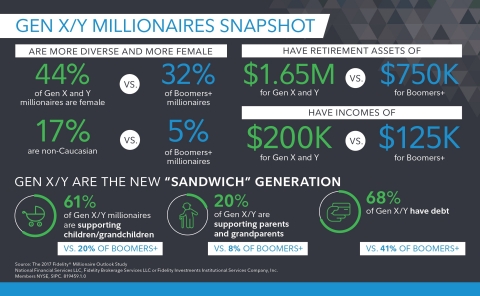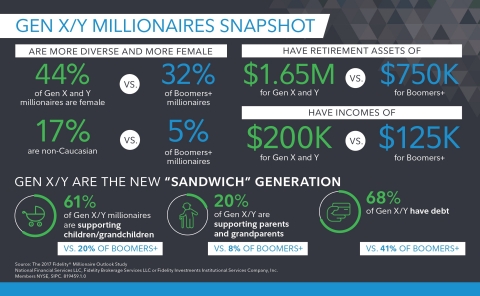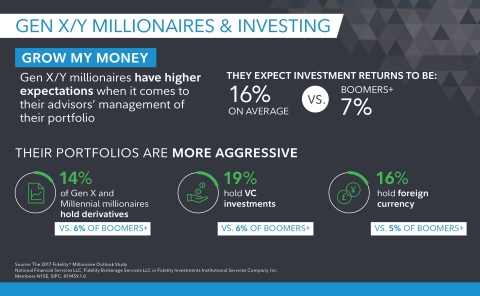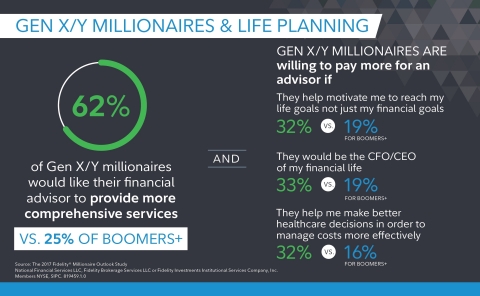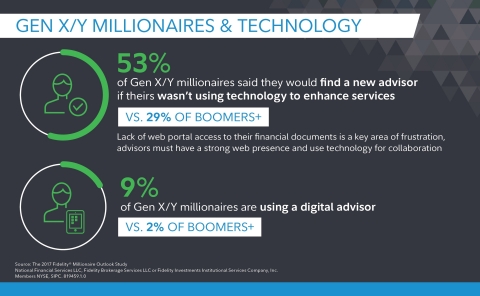BOSTON--(BUSINESS WIRE)--Fidelity Investments® released the results of its 9th Millionaire Outlook study today, which shows that the face of wealth is changing and is beginning to “tip” to Gen X and Millennials (Gen Y).2 Gen X/Y millionaires are at an inflection point due to their age and the complexity of their financial situations, and they look much different than older generations of millionaires do (see graphic).
And the differences don’t end there: the Fidelity Millionaire Outlook study found that Gen X/Y millionaires take a much different approach to money than Boomers (see graphic).
With the ranks of Gen X/Y millionaires growing fast (they were 8 percent of millionaires in 2012 and are now 18 percent3) and the fact that only 58 percent of them are currently working with a financial advisor (down from 72 percent five years ago), they represent both an opportunity and a risk for the wealth management industry. By 2030, Gen X/Y will surpass Baby Boomers in terms of holding the most wealth in the country.4
“With the percentage of Gen X/Y millionaires using an advisor on the decline, the industry needs to take a step back and ask: What can we be doing to ‘tip’ these investors toward valuing advice?” said David Canter, head of the registered investment advisor segment at Fidelity Clearing & Custody Solutions. “Gen X and Millennials don’t manage their finances in the same way that their parents did – they want an advisor who will be their own personal CFO and organize and simplify their financial lives.”
Key Takeaways for Advisors:
1. Sixty-nine percent of Gen X/Y
millionaires have referred at least one person to their advisor in the
past year (vs. 48 percent of Boomers), so consider gathering feedback on
your approach via client satisfaction surveys and advisory boards so
that you can tailor your services to this market.
2. Examine your
book of business to see if you’ve established relationships with your
current clients’ children in the Gen X/Y population. Forty-nine percent
are likely or very likely to meet with their parents’ advisor if
recommended, but only 16 percent of financial advisors are actively
targeting younger investors.5
3. Make sure you’re
providing online access to statements, reports and, financial records
via your website, an online portal, and/or an app, and staying on top of
the latest ways to enhance the client experience through technology.
4.
Given that Gen X/Y millionaires are looking for more than just
investment advice, consider taking steps to go beyond money management
and offer comprehensive services, for example, outlining how you can
help them stick to a financial plan and reach their goals.
5. Gen
X/Y prefers to consolidate assets with one advisor. Use data aggregation
tools to find outside assets, and bring up the ease of one-stop shopping
in conversations.
For more details on the study and to access Fidelity’s new report, The Tipping Point: Will the Coming Wave of Wealth Value Advice, visit go.fidelity.com/millionaireoutlook2017.
About the Fidelity Millionaire Outlook Study
The
2017 Fidelity® Millionaire Outlook Study was an online, blind
study conducted during the period January 18 through February 13, 2017.
The sample was provided by TNS, a third-party research firm not
affiliated with Fidelity. The study focused on understanding affluent
investors’ attitudes, goals, behaviors and preferences related to
investing, wealth management, and advice. Six hundred and one
participants were defined as “Millionaires” with $1 million or more in
total investable assets, excluding 401(k) and real estate investments.
About Fidelity Investments
Fidelity’s
mission is to inspire better futures and deliver better outcomes for the
customers and businesses we serve. With assets under administration of
$6.4 trillion, including managed assets of $2.3 trillion as of August
31, 2017, we focus on meeting the unique needs of a diverse set of
customers: helping more than 26 million people invest their own life
savings, 23,000 businesses manage employee benefit programs, as well as
providing more than 12,500 financial advisory firms with investment and
technology solutions to invest their own clients’ money. Privately held
for 70 years, Fidelity employs more than 40,000 associates who are
focused on the long-term success of our customers. For more information
about Fidelity Investments, visit https://www.fidelity.com/about.
The content provided herein is general in nature and is for
informational purposes only. This information is not individualized and
is not intended to serve as the primary or sole basis for your decisions
as there may be other factors you should consider.
Third party
marks are the property of their respective owners; all other marks are
the property of FMR LLC.
Fidelity Clearing & Custody Solutions®
provides clearing, custody, or other brokerage services through National
Financial Services LLC or Fidelity Brokerage Services LLC, Members NYSE,
SIPC. 200 Seaport Blvd, Boston, MA 02210
Products and services
provided through Fidelity Institutional Asset Management®
(FIAM®) to investment professionals, plan sponsors and
institutional investors by Fidelity Investments Institutional Services
Company, Inc., 500 Salem Street, Smithfield, RI 02917.
Fidelity
Brokerage Services LLC, Member NYSE, SIPC 900 Salem Street, Smithfield,
RI 02917
819459.1.0
© 2017 FMR LLC. All rights reserved.
1 Sources: Deloitte Center for Financial Services; Pew
Research Center; Age in the year 2017.
2 For the
purposes of this study, Gen Y (Millennials) is 21 to 35 years of age,
Gen X is 36 to 51 years of age and Boomers+ are 52 and older. The number
of Gen Y millionaires is 20, the number of Gen X millionaires is 49 and
the number of Boomers+ is 532.
3 According to the 2017
Fidelity Millionaire Outlook study, the number of Gen X and Millennial
millionaires has more than doubled in the past five years. For
comparison purposes, the Federal Reserve’s 2016 Survey of Consumer
Finances (SCF) indicates Gen X/Y Millionaire households comprise an
estimated 13.4% of Millionaire households, which is relatively flat
compared to 13.9% in its 2013 study, but indicates growth compared to
same proportion of Gen X/Y Millionaire households in 2010 which is
estimated at 10%. Different sampling and survey methodologies will
produce different results, but the general trend of growth over a
five-year period is consistent.2016 Federal Reserve Survey of Consumer
Finances.
4 Sources: Deloitte Center for Financial
Services; Pew Research Center; Age in the year 2017.
5
The 2017 Fidelity RIA Benchmarking Study was conducted between April 19
and June 6, 2017. 408 firms participated.

